MGMT 204 Principles: Starbucks Canada PESTEL Analysis & Market Factors
VerifiedAdded on 2023/06/06
|7
|1586
|479
Report
AI Summary
This report provides a PESTEL analysis of Starbucks Canada, examining the political, economic, socio-cultural, technological, environmental, and legal factors influencing its operations. The analysis reveals opportunities such as growing consumer demand for coffee, a well-informed aging population with disposable income, and increasing technology adoption. However, threats include increasing competition from companies like McDonalds and Burger King, and growing demands for sustainability and environmentally friendly practices. The report concludes that Starbucks must understand its external market to develop effective competitive strategies in Canada.
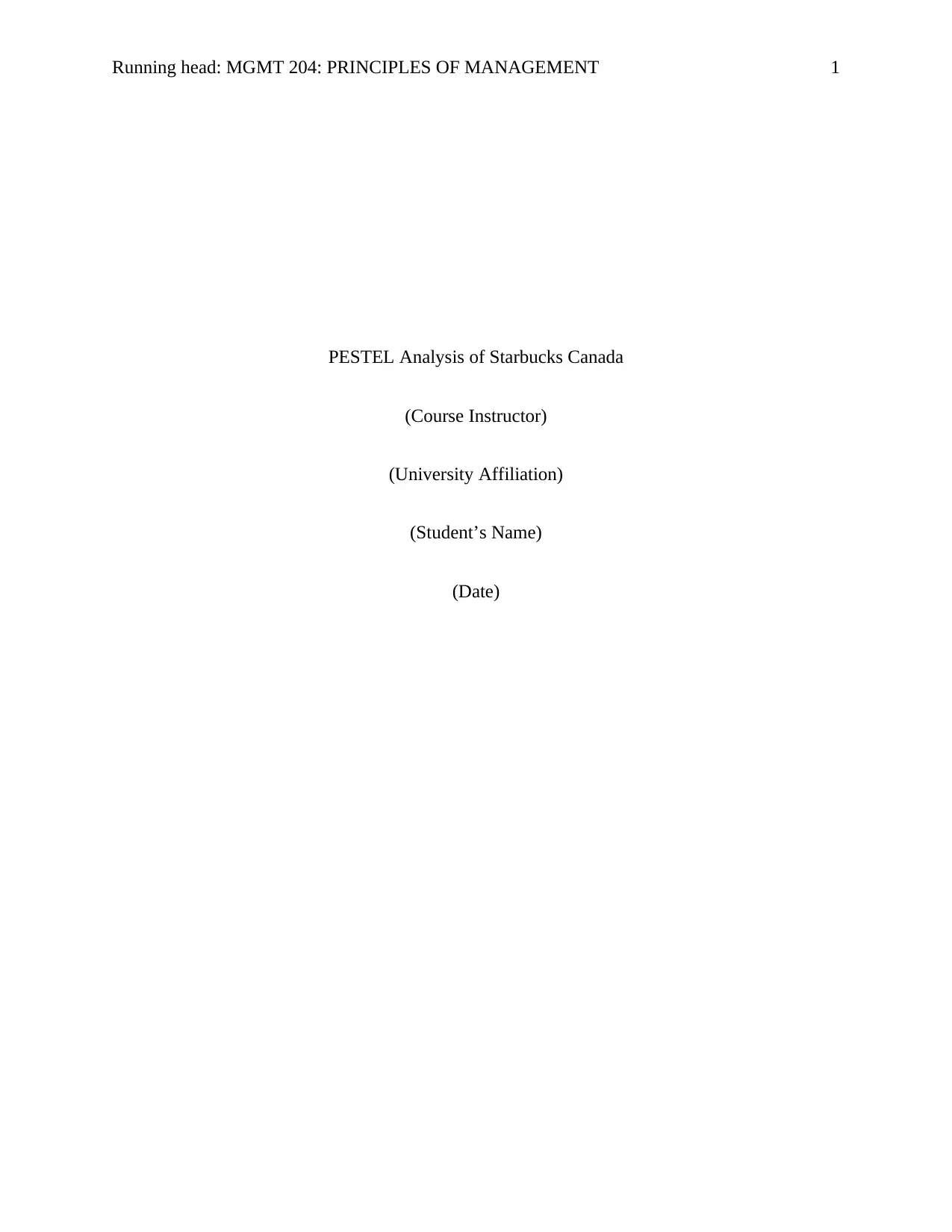
Running head: MGMT 204: PRINCIPLES OF MANAGEMENT 1
PESTEL Analysis of Starbucks Canada
(Course Instructor)
(University Affiliation)
(Student’s Name)
(Date)
PESTEL Analysis of Starbucks Canada
(Course Instructor)
(University Affiliation)
(Student’s Name)
(Date)
Paraphrase This Document
Need a fresh take? Get an instant paraphrase of this document with our AI Paraphraser
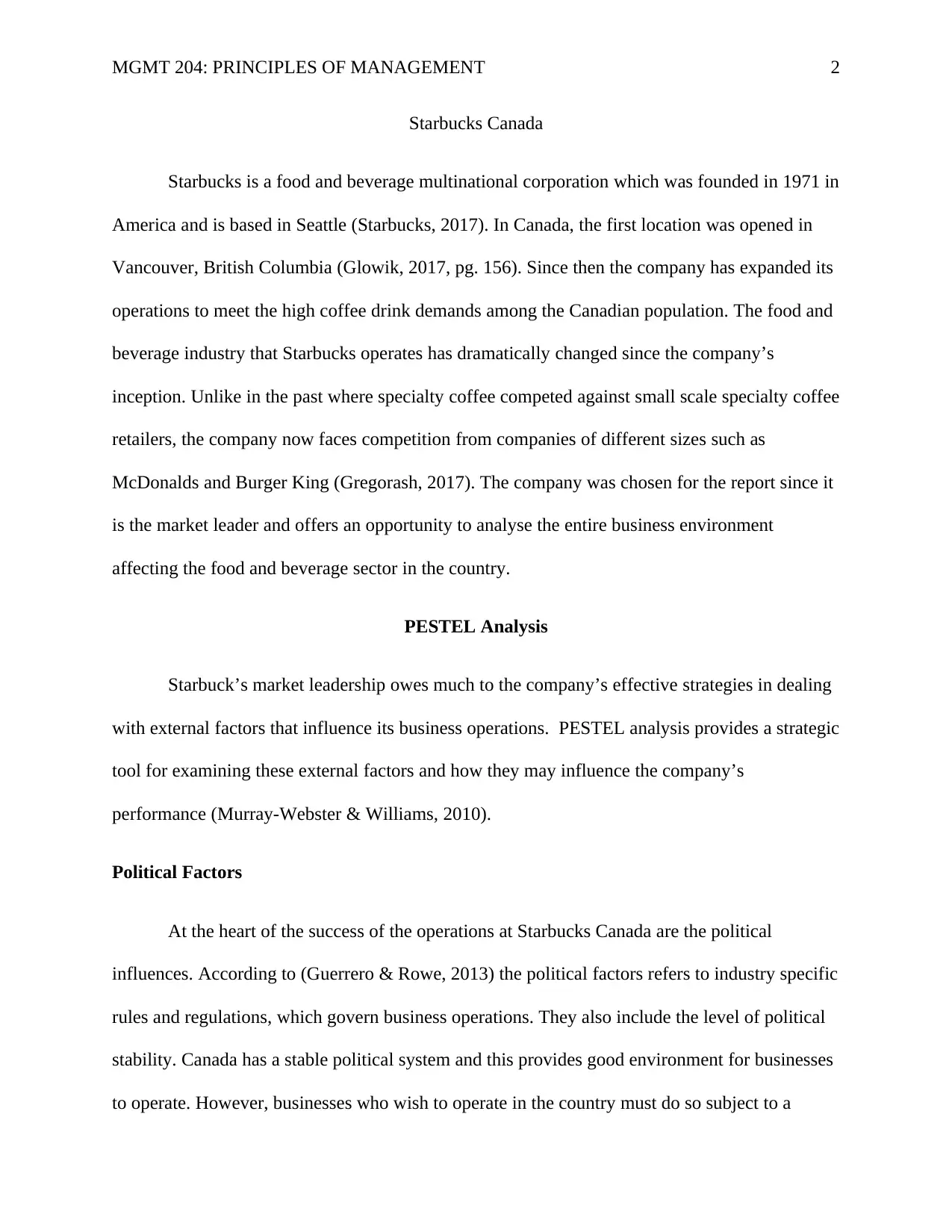
MGMT 204: PRINCIPLES OF MANAGEMENT 2
Starbucks Canada
Starbucks is a food and beverage multinational corporation which was founded in 1971 in
America and is based in Seattle (Starbucks, 2017). In Canada, the first location was opened in
Vancouver, British Columbia (Glowik, 2017, pg. 156). Since then the company has expanded its
operations to meet the high coffee drink demands among the Canadian population. The food and
beverage industry that Starbucks operates has dramatically changed since the company’s
inception. Unlike in the past where specialty coffee competed against small scale specialty coffee
retailers, the company now faces competition from companies of different sizes such as
McDonalds and Burger King (Gregorash, 2017). The company was chosen for the report since it
is the market leader and offers an opportunity to analyse the entire business environment
affecting the food and beverage sector in the country.
PESTEL Analysis
Starbuck’s market leadership owes much to the company’s effective strategies in dealing
with external factors that influence its business operations. PESTEL analysis provides a strategic
tool for examining these external factors and how they may influence the company’s
performance (Murray-Webster & Williams, 2010).
Political Factors
At the heart of the success of the operations at Starbucks Canada are the political
influences. According to (Guerrero & Rowe, 2013) the political factors refers to industry specific
rules and regulations, which govern business operations. They also include the level of political
stability. Canada has a stable political system and this provides good environment for businesses
to operate. However, businesses who wish to operate in the country must do so subject to a
Starbucks Canada
Starbucks is a food and beverage multinational corporation which was founded in 1971 in
America and is based in Seattle (Starbucks, 2017). In Canada, the first location was opened in
Vancouver, British Columbia (Glowik, 2017, pg. 156). Since then the company has expanded its
operations to meet the high coffee drink demands among the Canadian population. The food and
beverage industry that Starbucks operates has dramatically changed since the company’s
inception. Unlike in the past where specialty coffee competed against small scale specialty coffee
retailers, the company now faces competition from companies of different sizes such as
McDonalds and Burger King (Gregorash, 2017). The company was chosen for the report since it
is the market leader and offers an opportunity to analyse the entire business environment
affecting the food and beverage sector in the country.
PESTEL Analysis
Starbuck’s market leadership owes much to the company’s effective strategies in dealing
with external factors that influence its business operations. PESTEL analysis provides a strategic
tool for examining these external factors and how they may influence the company’s
performance (Murray-Webster & Williams, 2010).
Political Factors
At the heart of the success of the operations at Starbucks Canada are the political
influences. According to (Guerrero & Rowe, 2013) the political factors refers to industry specific
rules and regulations, which govern business operations. They also include the level of political
stability. Canada has a stable political system and this provides good environment for businesses
to operate. However, businesses who wish to operate in the country must do so subject to a
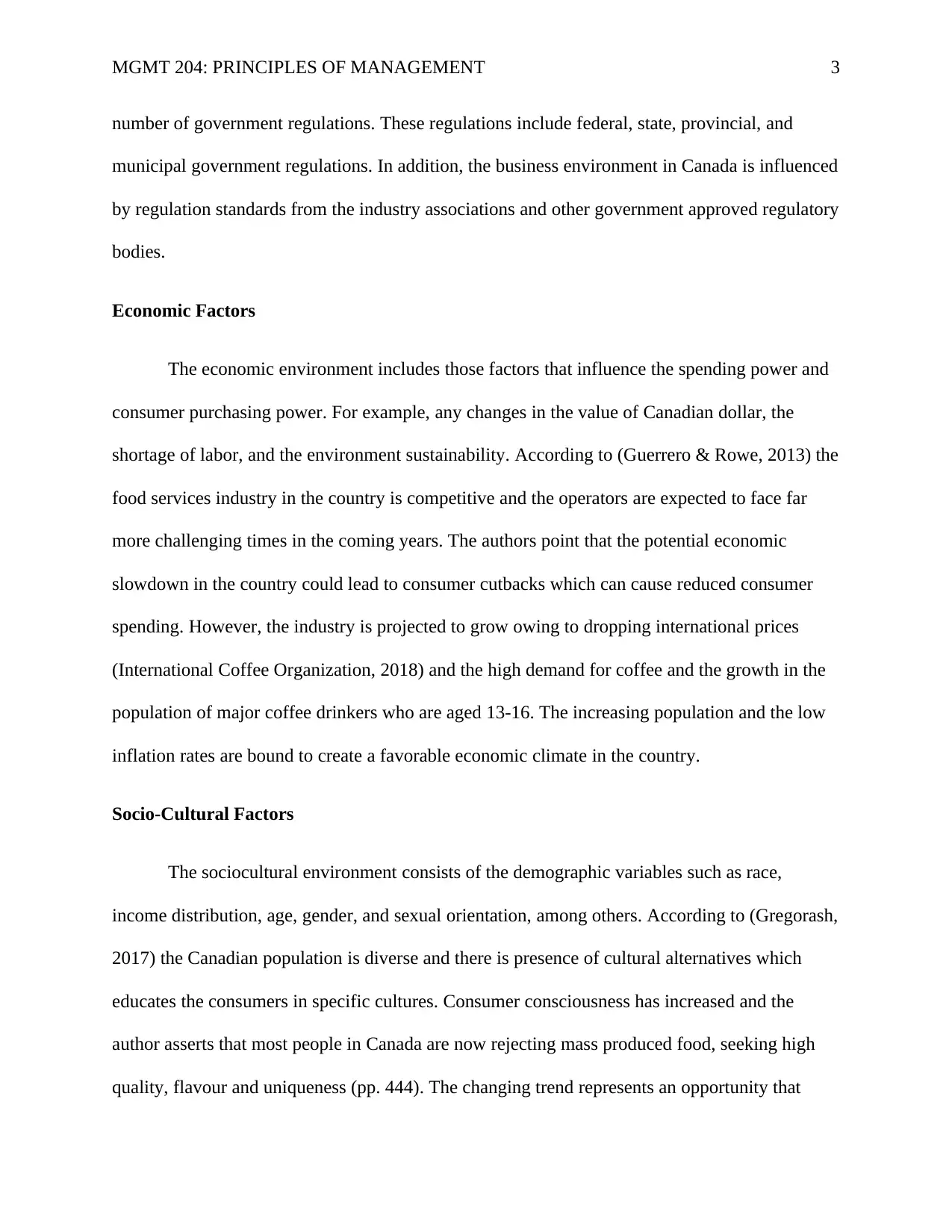
MGMT 204: PRINCIPLES OF MANAGEMENT 3
number of government regulations. These regulations include federal, state, provincial, and
municipal government regulations. In addition, the business environment in Canada is influenced
by regulation standards from the industry associations and other government approved regulatory
bodies.
Economic Factors
The economic environment includes those factors that influence the spending power and
consumer purchasing power. For example, any changes in the value of Canadian dollar, the
shortage of labor, and the environment sustainability. According to (Guerrero & Rowe, 2013) the
food services industry in the country is competitive and the operators are expected to face far
more challenging times in the coming years. The authors point that the potential economic
slowdown in the country could lead to consumer cutbacks which can cause reduced consumer
spending. However, the industry is projected to grow owing to dropping international prices
(International Coffee Organization, 2018) and the high demand for coffee and the growth in the
population of major coffee drinkers who are aged 13-16. The increasing population and the low
inflation rates are bound to create a favorable economic climate in the country.
Socio-Cultural Factors
The sociocultural environment consists of the demographic variables such as race,
income distribution, age, gender, and sexual orientation, among others. According to (Gregorash,
2017) the Canadian population is diverse and there is presence of cultural alternatives which
educates the consumers in specific cultures. Consumer consciousness has increased and the
author asserts that most people in Canada are now rejecting mass produced food, seeking high
quality, flavour and uniqueness (pp. 444). The changing trend represents an opportunity that
number of government regulations. These regulations include federal, state, provincial, and
municipal government regulations. In addition, the business environment in Canada is influenced
by regulation standards from the industry associations and other government approved regulatory
bodies.
Economic Factors
The economic environment includes those factors that influence the spending power and
consumer purchasing power. For example, any changes in the value of Canadian dollar, the
shortage of labor, and the environment sustainability. According to (Guerrero & Rowe, 2013) the
food services industry in the country is competitive and the operators are expected to face far
more challenging times in the coming years. The authors point that the potential economic
slowdown in the country could lead to consumer cutbacks which can cause reduced consumer
spending. However, the industry is projected to grow owing to dropping international prices
(International Coffee Organization, 2018) and the high demand for coffee and the growth in the
population of major coffee drinkers who are aged 13-16. The increasing population and the low
inflation rates are bound to create a favorable economic climate in the country.
Socio-Cultural Factors
The sociocultural environment consists of the demographic variables such as race,
income distribution, age, gender, and sexual orientation, among others. According to (Gregorash,
2017) the Canadian population is diverse and there is presence of cultural alternatives which
educates the consumers in specific cultures. Consumer consciousness has increased and the
author asserts that most people in Canada are now rejecting mass produced food, seeking high
quality, flavour and uniqueness (pp. 444). The changing trend represents an opportunity that
⊘ This is a preview!⊘
Do you want full access?
Subscribe today to unlock all pages.

Trusted by 1+ million students worldwide

MGMT 204: PRINCIPLES OF MANAGEMENT 4
Starbucks can exploit by incorporating the new cultural trends in consumption patterns of the
consumers. Also, the country has large portion of aging population who are well informed and
are living longer with a lot of disposable income. In addition, large and diverse population
growth owing to influx of immigrants and growing economy has improved the disposable
income, which offers a significant opportunity for coffee and other fast food businesses.
Technological Factors
The technological environment includes work methods, human knowledge, physical
equipment, business processing systems, and electronics and other telecommunication devices
(Rao, 2007). There has been tremendous change in technology over the past years, which has
seen rise in mobile-based applications and product and service technologies. The uptake of
technology in the food and beverage sector in Canada is tremendous. Some companies such as
SunChips has employed solar energy in one of its manufacturing units to manufacture better
consumer snacks which are environmentally friendly. The huge penetration and uptake of
technology in the country, provides a key tool through which companies such as Starbucks can
exploit to gain a competitive advantage.
Environment
Like any other country, there are increasing demands for environmentally friendly
business processes in Canada. The external macro-environmental factors that Starbucks faces in
Canada include sustainability efforts, responsible sourcing, and growing needs for
environmentally friendly products. The company has developed responsible sourcing polices,
offers its products in recyclable packaging and participates in corporate social responsibility
practices.
Starbucks can exploit by incorporating the new cultural trends in consumption patterns of the
consumers. Also, the country has large portion of aging population who are well informed and
are living longer with a lot of disposable income. In addition, large and diverse population
growth owing to influx of immigrants and growing economy has improved the disposable
income, which offers a significant opportunity for coffee and other fast food businesses.
Technological Factors
The technological environment includes work methods, human knowledge, physical
equipment, business processing systems, and electronics and other telecommunication devices
(Rao, 2007). There has been tremendous change in technology over the past years, which has
seen rise in mobile-based applications and product and service technologies. The uptake of
technology in the food and beverage sector in Canada is tremendous. Some companies such as
SunChips has employed solar energy in one of its manufacturing units to manufacture better
consumer snacks which are environmentally friendly. The huge penetration and uptake of
technology in the country, provides a key tool through which companies such as Starbucks can
exploit to gain a competitive advantage.
Environment
Like any other country, there are increasing demands for environmentally friendly
business processes in Canada. The external macro-environmental factors that Starbucks faces in
Canada include sustainability efforts, responsible sourcing, and growing needs for
environmentally friendly products. The company has developed responsible sourcing polices,
offers its products in recyclable packaging and participates in corporate social responsibility
practices.
Paraphrase This Document
Need a fresh take? Get an instant paraphrase of this document with our AI Paraphraser

MGMT 204: PRINCIPLES OF MANAGEMENT 5
Legal Factors
The legal factors in the external environment analysis include the regulations and laws
that govern the business operations. The legal factors of concern to people wishing to start
businesses in Canada include product safety regulations, the regulations that govern use of
genetically modified crops, and the regulations that govern employment (Willie, Pirani,
Jayawardena, Sovani & Davoodi, 2013). The regulations that allow the use of genetically
modified crops offer an opportunity, whereas the increasing employment regulations are possible
threats to conduct of business in the country.
External Analysis
Opportunities and Threats
The major sources of opportunities in the food and beverage industry in Canada are the
growing consumer demands. According to (Guerrero & Rowe, 2013) though the industry is
becoming so competitive, there is an increasing consumer demands for coffee in the country. The
other opportunity is the aging population that is well educated with high income levels. Such
population offers an opportunity for increasing the company revenues through sustained
increased sales of coffee.
However, increased sustainability efforts that demand green energy and processes is a
major threat. The company has been criticised by environmental groups for lack of recycling of
its coffee mugs, which end up in dumpsites. Moreover, there emergence of other players in the
food and beverage industry who fight for the same market segment as Starbucks offers a major
threat to the company. According to (Guerrero & Rowe, 2013) companies such as McDonalds
Legal Factors
The legal factors in the external environment analysis include the regulations and laws
that govern the business operations. The legal factors of concern to people wishing to start
businesses in Canada include product safety regulations, the regulations that govern use of
genetically modified crops, and the regulations that govern employment (Willie, Pirani,
Jayawardena, Sovani & Davoodi, 2013). The regulations that allow the use of genetically
modified crops offer an opportunity, whereas the increasing employment regulations are possible
threats to conduct of business in the country.
External Analysis
Opportunities and Threats
The major sources of opportunities in the food and beverage industry in Canada are the
growing consumer demands. According to (Guerrero & Rowe, 2013) though the industry is
becoming so competitive, there is an increasing consumer demands for coffee in the country. The
other opportunity is the aging population that is well educated with high income levels. Such
population offers an opportunity for increasing the company revenues through sustained
increased sales of coffee.
However, increased sustainability efforts that demand green energy and processes is a
major threat. The company has been criticised by environmental groups for lack of recycling of
its coffee mugs, which end up in dumpsites. Moreover, there emergence of other players in the
food and beverage industry who fight for the same market segment as Starbucks offers a major
threat to the company. According to (Guerrero & Rowe, 2013) companies such as McDonalds
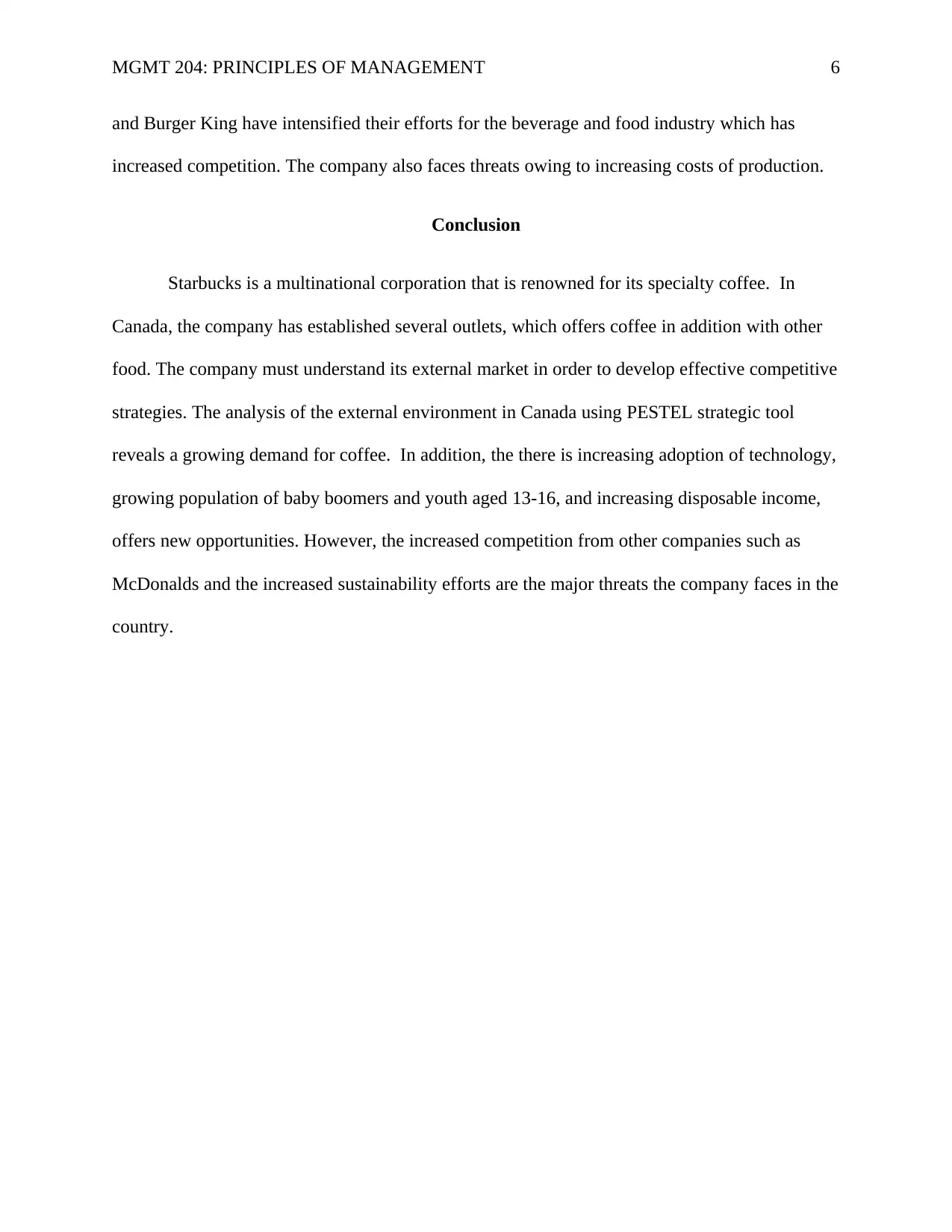
MGMT 204: PRINCIPLES OF MANAGEMENT 6
and Burger King have intensified their efforts for the beverage and food industry which has
increased competition. The company also faces threats owing to increasing costs of production.
Conclusion
Starbucks is a multinational corporation that is renowned for its specialty coffee. In
Canada, the company has established several outlets, which offers coffee in addition with other
food. The company must understand its external market in order to develop effective competitive
strategies. The analysis of the external environment in Canada using PESTEL strategic tool
reveals a growing demand for coffee. In addition, the there is increasing adoption of technology,
growing population of baby boomers and youth aged 13-16, and increasing disposable income,
offers new opportunities. However, the increased competition from other companies such as
McDonalds and the increased sustainability efforts are the major threats the company faces in the
country.
and Burger King have intensified their efforts for the beverage and food industry which has
increased competition. The company also faces threats owing to increasing costs of production.
Conclusion
Starbucks is a multinational corporation that is renowned for its specialty coffee. In
Canada, the company has established several outlets, which offers coffee in addition with other
food. The company must understand its external market in order to develop effective competitive
strategies. The analysis of the external environment in Canada using PESTEL strategic tool
reveals a growing demand for coffee. In addition, the there is increasing adoption of technology,
growing population of baby boomers and youth aged 13-16, and increasing disposable income,
offers new opportunities. However, the increased competition from other companies such as
McDonalds and the increased sustainability efforts are the major threats the company faces in the
country.
⊘ This is a preview!⊘
Do you want full access?
Subscribe today to unlock all pages.

Trusted by 1+ million students worldwide
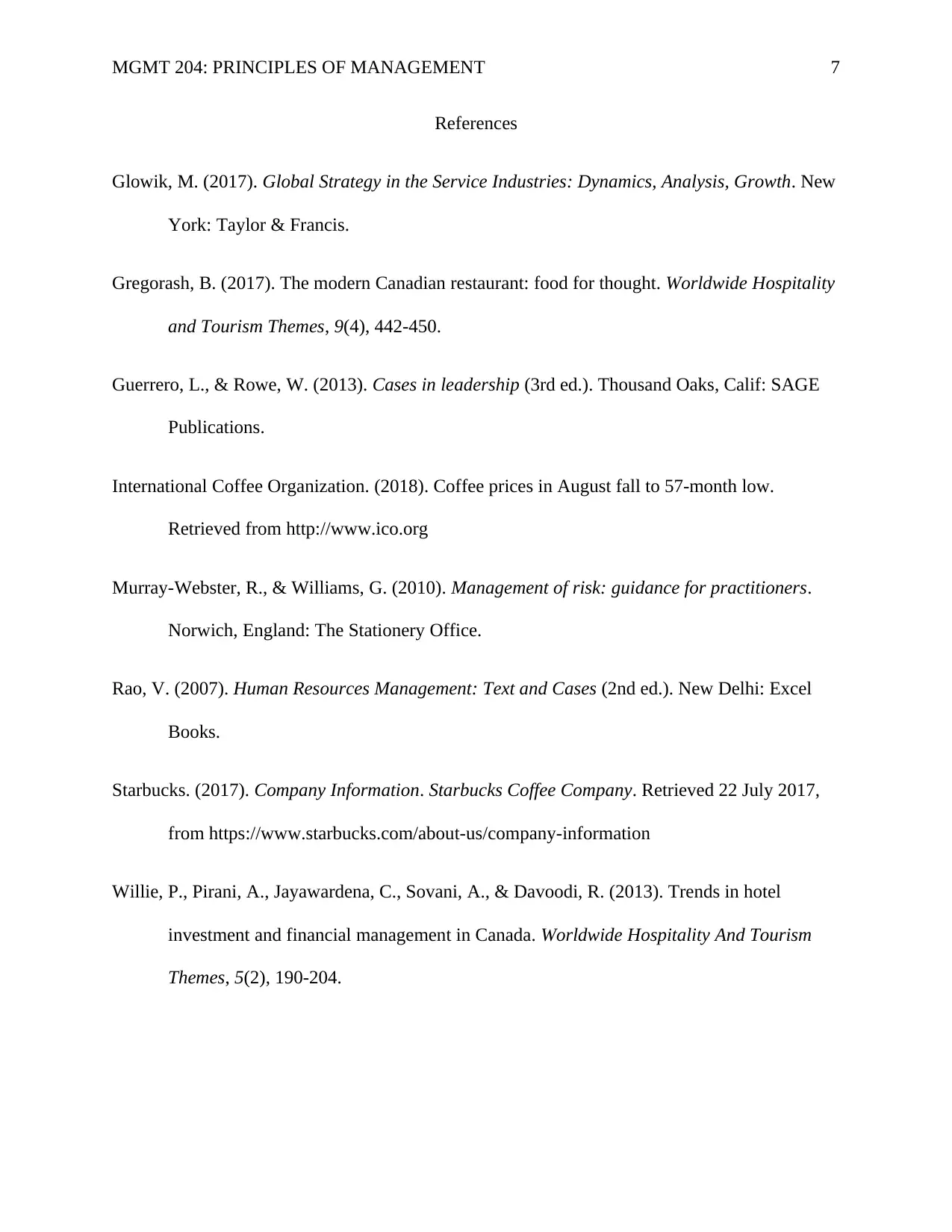
MGMT 204: PRINCIPLES OF MANAGEMENT 7
References
Glowik, M. (2017). Global Strategy in the Service Industries: Dynamics, Analysis, Growth. New
York: Taylor & Francis.
Gregorash, B. (2017). The modern Canadian restaurant: food for thought. Worldwide Hospitality
and Tourism Themes, 9(4), 442-450.
Guerrero, L., & Rowe, W. (2013). Cases in leadership (3rd ed.). Thousand Oaks, Calif: SAGE
Publications.
International Coffee Organization. (2018). Coffee prices in August fall to 57-month low.
Retrieved from http://www.ico.org
Murray-Webster, R., & Williams, G. (2010). Management of risk: guidance for practitioners.
Norwich, England: The Stationery Office.
Rao, V. (2007). Human Resources Management: Text and Cases (2nd ed.). New Delhi: Excel
Books.
Starbucks. (2017). Company Information. Starbucks Coffee Company. Retrieved 22 July 2017,
from https://www.starbucks.com/about-us/company-information
Willie, P., Pirani, A., Jayawardena, C., Sovani, A., & Davoodi, R. (2013). Trends in hotel
investment and financial management in Canada. Worldwide Hospitality And Tourism
Themes, 5(2), 190-204.
References
Glowik, M. (2017). Global Strategy in the Service Industries: Dynamics, Analysis, Growth. New
York: Taylor & Francis.
Gregorash, B. (2017). The modern Canadian restaurant: food for thought. Worldwide Hospitality
and Tourism Themes, 9(4), 442-450.
Guerrero, L., & Rowe, W. (2013). Cases in leadership (3rd ed.). Thousand Oaks, Calif: SAGE
Publications.
International Coffee Organization. (2018). Coffee prices in August fall to 57-month low.
Retrieved from http://www.ico.org
Murray-Webster, R., & Williams, G. (2010). Management of risk: guidance for practitioners.
Norwich, England: The Stationery Office.
Rao, V. (2007). Human Resources Management: Text and Cases (2nd ed.). New Delhi: Excel
Books.
Starbucks. (2017). Company Information. Starbucks Coffee Company. Retrieved 22 July 2017,
from https://www.starbucks.com/about-us/company-information
Willie, P., Pirani, A., Jayawardena, C., Sovani, A., & Davoodi, R. (2013). Trends in hotel
investment and financial management in Canada. Worldwide Hospitality And Tourism
Themes, 5(2), 190-204.
1 out of 7
Related Documents
Your All-in-One AI-Powered Toolkit for Academic Success.
+13062052269
info@desklib.com
Available 24*7 on WhatsApp / Email
![[object Object]](/_next/static/media/star-bottom.7253800d.svg)
Unlock your academic potential
Copyright © 2020–2025 A2Z Services. All Rights Reserved. Developed and managed by ZUCOL.




